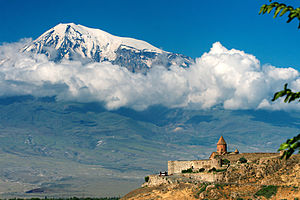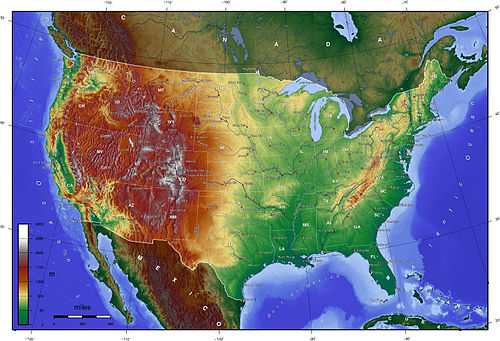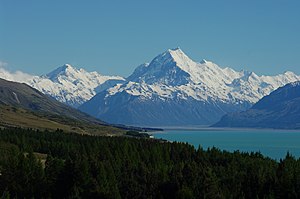Mountain ranges are regions of the earth with a high concentration of mountains.
Understand
edit| “ | We are all, in some sense, mountaineers, and going to the mountains is going home. | ” |
—John Muir | ||

A mountain range is an area of geologically-related mountains. They are typically created by plate tectonics (such as the Andes in South America) but can also be formed by other processes. The islands of Hawaii are actually the summits of an underwater mountain range formed by volcanoes.
Mountain ranges are good places to find the beginnings of rivers, particularly those that go a long way. For example, the Amazon River begins in the Andes Mountains in South America, and the Missouri River begins in the Rocky Mountains in North America. However, these sections of rivers are usually narrow, unlike the wide rivers you can find in flatter regions.
While mountain ranges are generally associated with being far above sea level, there are actually mountain ranges deep under the surface of the oceans. The best example is the Mid-Atlantic Ridge.
Prepare
editSee Mountaineering for advice around preparing for mountain climbing in general and Altitude sickness, Cold weather and Snow safety for some of the risks. The individual mountains vary in size and features, and treks can be chosen according to your level of fitness and experience.
Destinations
editAfrica
edit- The 1 Atlas Mountains are in Algeria, Morocco and Tunisia, leading in their southeast to the Sahara Desert.
- 2 Eastern Rift Mountains
- The 3 Drakensberg, in South Africa
Antarctica
edit- Most of Antarctica is on a high plateau – the South Pole is at 2835 meters (9301 ft) altitude – but it's mostly a featureless plain.
- The 4 Transantarctic Mountains traverse the continent from the Weddell Sea to the Ross Sea.
- Mount Vinson, the highest peak at 4892 m (16,050 ft), is in a separate massif in the Ellsworth Mountains of West Antarctica.
Asia
editWestern Asia
edit
- The 5 Judaean Mountains are in Israel and the West Bank.
- The 6 Pontic Mountains (also known as the Pontic Alps) stretch along Turkey's Black Sea coast.
- The 7 Taurus, Anti-Taurus, and Eastern Taurus Mountains form a massive range extending from the Mediterranean coast of Turkey to the Iranian border. Mount Nemrut is in the eastern part of the range, famous for the ancient statues near its summit.
- The 8 Zagros Mountains are mostly found along Iran's western border, but also reach through Iraq. Geologically they are interlinked with the Taurus of Turkey.
East Asia
edit- The 9 Baekdu Mountains are on the border between North Korea and China, and considered the origin of the Korean people. The Chinese part is known as Changbai.
- 10 Japan Alps
- The 11 Taebaek Mountains run down the east coast of the Korean peninsular, and include Kumgangsan and Seoraksan.
- The 12 Central Mountain Range runs up the centre of Taiwan from south to north, separating the more developed and densely populated West Coast from the more rural, sparsely populated and typhoon-prone East Coast. It includes some of Taiwan's most popular tourist attractions, including Jiufen, Alishan, Yangmingshan and the Taroko Gorge.
South Asia
edit- The 13 Himalayas are the high southeastern fork of a large mountainous area in Central, South, East and Southeast Asia comprising several mountain chains such as Karakoram, Pamir Mountains, Altai, Tian Shan, Hindu Kush and Kunlun. All the world's mountains above 7,000 m (23,000 ft) are in the Himalayas or one of these other mountain ranges. However, the Himalayas contain the highest peaks of all, including Mount Everest, Annapurna and K2. They also include the Tibetan Plateau. The southern side is wetter, while the northern side is dry.
- 14 Knuckles Mountain Range in Sri Lanka
Southeast Asia
edit- The Himalayas continue into Southeast Asia as the 15 Shan Hills, largely straddling the border between Myanmar and China, but also extending into Northern Thailand. It includes some of Myanmar's most popular tourist attractions such as Inle Lake and the colonial hill stations of Pyin U Lwin and Kalaw. The capital of Shan State Taunggyi is also within this region. The Thai part of the Shan Hills is known as the 16 Thanon Thong Chai Range.
- 17 Banjaran Titiwangsan runs up the centre of Peninsular Malaysia into Southern Thailand, separating the more cosmopolitan and developed West Coast from the more traditional Malay Muslim and less developed East Coast. It is home to some of Malaysia's most famous colonial hill stations such as Fraser's Hill and Cameron Highlands.
Europe
edit
- The 18 Alps both divide and connect the European continent. They are perhaps the most "developed" mountain range in the world, particularly in terms of downhill snowsports. The Alps can be found in several European countries, but the countries they dominate most are the small nations of Switzerland and Austria.
- The 19 Apennines are in Italy.
- The 20 Balkan Mountains are in southern Europe.
- The 21 Rhodope Mountains stretch along the Greek-Bulgarian border in southern Europe. It is a sparsely populated area rich in rare cultural sites of the ancient Thracians and with impressive areas of exceptional natural beauty
- The 22 Carpathian Mountains are in Central and Eastern Europe.
- The 23 Caucasus Ranges extend from west to east and are regarded as a geographical border between Europe and Asia.
- The 24 Dinaric Alps cover much of the western Balkans.
- The 25 Harz mountains were once divided by the Iron Curtain and are still in two separate Bundesländer. They are the northernmost mountain range in Germany.
- The 26 Pyrenees are a high mountain range — at least by European standards — shared by France, Spain and Andorra. Moreover, much of the Iberian peninsula is mountainous, made up of numerous smaller mountain ranges.
- The 27 cover most of Norway, a considerable part of northwestern Sweden and some of northwestern Finland.
- The 28 Scottish Highlands are found in the more remote parts of Scotland, at the northern end of the island of Great Britain. Although the highest peak, Ben Nevis is only 4,413 ft (1,345 m) many mountain walks start from sea level.
- The 29 Tatras are in Poland and Slovakia. The highest peak is 2,655 m (8,711 ft).
- The 30 Urals are a Russian mountain range that are often regarded as the border between Europe and Asia.
North America
editMountains stretch continuously across the western side of the continent, embracing the Canadian Rockies, the Rocky Mountains, and the Sierra Madre. All of these ranges embrace smaller, local ranges within them and adjacent to them, forming what geologists refer to as the North American Cordillera.
Canada
edit- The 31 Canadian Rockies are the northward continuation of the Rocky Mountains into Canada. It is home to some of Canada's most beloved national parks, including Banff National Park, Jasper National Park and Yoho National Park
- The Columbia Mountains on the west side of the Rocky Mountain Trench are considered to be part of the Rocky Mountains in the U.S., but a separate mountain range in Canada. Glacier National Park can be found here.
- The Canadian portions of the Pacific Coast Ranges include:
- The Saint Elias Mountains, starting in southeast Alaska but primarily in southwest Yukon and the far northwest of British Columbia, are the world's highest coastal range. They include Canada's highest peak, Mount Logan in Yukon, which is second only to Denali on the continent.
- The Coast Mountains start in southwest Yukon, continue through the Alaska panhandle, and run along almost all of the British Columbia coast. While not nearly as high as the Saint Elias range, they are comparable to the Rockies in height and scope.
- The Insular Mountains of Vancouver Island in British Columbia are not nearly as high as the Coast Mountains, but offer dramatic views.
- The Fitzsimmons Range in southwestern British Columbia is home to Canada's most popular ski resort Whistler.
- The 32 Laurentians are an extension of the Appalachian range into Quebec. They include a number of popular ski resorts.
Mexico
editMexico's Sierra Madre Mountains are a continuation of the Rocky Mountains (actually the North American Cordillera). The Sierra Madre are usually referred to as three major mountain ranges surrounding a large central high plain known as the Altiplano. Several other smaller range names are used locally, though all are part of the Sierra Madre.
- 33 Sierra Madre Occidental is the largest mountainous area in Mexico, running along the western side of the country, including much of the states of Sonora and Chihuahua. The Sierra Madre Occidental includes a number of smaller, regional mountain ranges, several national parks (including the scenic Sierra de Organos National Park), and the famous Copper Canyon with its deep ravines, sheer drops, and one of the world's most iconic train rides.
- 34 Sierra Madre Oriental is the mountainous region south of the eastern Mexico/U.S. border and extending south toward Mexico City. The range includes much of the states of Coahuila and Nuevo Leon, as well as areas of Tamaulipas and San Luis Potosi. Several national parks are located in this mountain range, including Mexico's largest non-marine park, Cumbres de Monterrey National Park.
- 35 Sierra Madre del Sur is the southernmost mountainous region in Mexico extending to the border of Guatemala. It includes most of the states of Oaxaca, Guerrero and large areas of neighboring states.
The Sierra de Baja California is a range that runs across the length of the Baja peninsula. Geologically, it is part of the Sierra Madre Occidental (despite having the Gulf of California in between).
A region of very high volcanic activity called the Trans Mexican Volcano Belt stretches across Central Mexico and includes areas of both the Sierra Madre Occidental and the Sierra Madre Oriental. This is not a separate mountain range, but is an area with frequent eruptions and earthquakes. It is also a concentration of Mexico's highest peaks. The 19 highest peaks in Mexico are all within this area, including three peaks over 5,000 m (16,404 ft): Pico de Orizaba (5,610 m), Popocatapetl (5,426 m), and Iztaccihuatl (5,220 m). Many of the major mountains and volcanoes of this region are part of Mexico national parks.
United States
edit
- There is a long chain of 36 Appalachian Mountains in the eastern United States, extending into Québec as the Laurentian Mountains (see the Canada section above). They're not particularly high mountains, but they stand out because they are in a part of North America without many mountains. They are well-known for their autumn scenery; since the Appalachians are covered by deciduous forests, they have the fall colors not found in mountain ranges with evergreen forests, and are also home to numerous ski resorts, particularly in Vermont. The Great Smoky Mountains National Park and the Appalachian Trail provide plenty of hiking options in the Appalachians.
- The 37 Alaska Range includes Denali (also known as Mount McKinley), the highest mountain in North America. Denali is a long way north, being west of Canada in the U.S. state of Alaska as the name of the mountain range implies.
- The 38 Black Hills are in the southwestern part of South Dakota.
- The 39 Cascade Mountains are in the western United States, not very far from the Pacific Coast, and are part of the Pacific Coast Ranges (see below). They are north of the Sierra Nevada Range and, for practical purposes are part of the same range. They are a good destination if you want to see volcanoes like Mount Rainier and Mount Lassen; however, these volcanoes are not safe, and Mount Saint Helens is a "good" example of a volcano in the range that erupted powerfully. Crater Lake is a popular destination in the Cascades.
- The Pacific Coast Ranges are a series of ranges stretching along the continent's west coast from Alaska to Mexico. These ranges vary widely in height, and not all of them are right on the coast; however, since in many places they extend right up to the coastline, the coastal views are very dramatic in many places. Ranges in this system in the U.S. include:
- The Alaskan portion of the Coast Mountains, which also lie in a small part of Yukon and almost all of the British Columbia coast in Canada.
- The Olympic Mountains are the central feature of the Olympic Peninsula of Washington, with most of the range lying within Olympic National Park.
- The Oregon Coast Range, along that state's coast, and the California Coast Ranges in the western and southern portions of California.
- The Transverse Ranges of southern California feature that region's highest points.
- There are many mountain ranges in the Great Basin region of the Western United States. These mountain ranges more closely resemble the eastern side of the Sierra Mountains than the western side of that range. Great Basin National Park, the location of Wheeler Peak, is a U.S. National Park in the Great Basin.

- The 40 Ozarks is a hilly region in the Southern United States.
- The U.S. portion of the 41 Rocky Mountains is centered in the state of Colorado, west of the city of Denver, which is also widely regarded as the premier skiing destination in the United States. Park City, Utah, where the skiing events of the 2002 Winter Olympics were held, is another popular skiing destination in the U.S. Rockies. Grand Teton National Park, Yellowstone National Park and Glacier National Park can also be found here.
- The 42 Sierra Nevada Range in California (often referred to as the "Sierras") includes the highest mountain peak in the contiguous United States, Mount Whitney. Unlike the Cascades to the north, the Sierras are free of volcanoes, and therefore you don't get individual, large mountains. The western side of the Sierras is a much more gradual slope than the eastern side; the eastern side marks the western end of the Great Basin. Popular destinations in the Sierras include Lake Tahoe and three national parks: Yosemite, Kings Canyon, and Sequoia.
Oceania
editAustralia
edit- The 43 Great Dividing Range runs along the east coast of Australia, to which the Blue Mountains, Snowy Mountains and Grampians belong. It separates the more fertile east coast of Australia from the more arid rest of the country.
- The 44 MacDonnell Ranges are in the centre of the Australian continent
- The 45 Flinders Ranges are in the South Australia, about 200km north of Adelaide, stretching over 400km from Port Pirie to Lake Callabonna.
- The 46 Mount Lofty Ranges are the southern continuation of the Flinders Ranges, with the part in the vicinity of Adelaide known as the Adelaide Hills. It is home to three of Australia's premier wine regions: the Clare Valley, Barossa Valley and McLaren Vale.
- The 47 Darling Scarp are in southwest Australia near Perth
New Caledonia
edit- The 48 Chaîne Centrale mountain range run in the middle of the Grande Terre
New Zealand
edit
- The 49 Southern Alps in the South Island of New Zealand.
- The 50 Central North Island has some mountains.
New Guinea
edit- The 51 New Guinea Highlands are on the island of New Guinea; the highlands are among the few places where glaciers can be found near the equator.
South America
edit- The 52 Andes Mountain Range includes Aconcagua, a mountain peak at nearly 7,000 m (23,000 ft) above sea level. Aconcagua is the highest mountain outside the Himalayas and mountain ranges near the Himalayas. The Andes Mountains extend north-south through all of the South American continent and they are, therefore, one of the largest mountain ranges (if not the largest) in the world in length and width. You can find Andes Mountains in most of the countries in South America, including Peru, Bolivia, Chile, and Argentina. In the far south of the mountain range is the Patagonia region.
- The 53 Pakaraima Mountains are a flat-topped mountain range between the Amazon Basin and the Orinoco valley.
- The 54 Sierra Nevada de Santa Marta is a coastal mountain range in the far north of Colombia that contains the country's highest peaks. Although often associated with the Andes, it is actually completely detached from that chain—even though the range tops out at over 5,700 m (18,700 ft), it is completely surrounded by lands lower than 200 m. This makes this range's high point the world's fifth most-prominent peak (after Everest, Aconcagua, Denali, and Kilimanjaro).
See also
edit- Hiking in the United States
- Hiking in the Nordic countries
- Hiking destinations in Norway
- Mountaineering
- Seven Summits – Climb the highest mountain in each of the 7 continents
- Tramping in New Zealand
- Volcanoes
- Winter sports are often done in mountain ranges which have snow for longer than lower areas.

